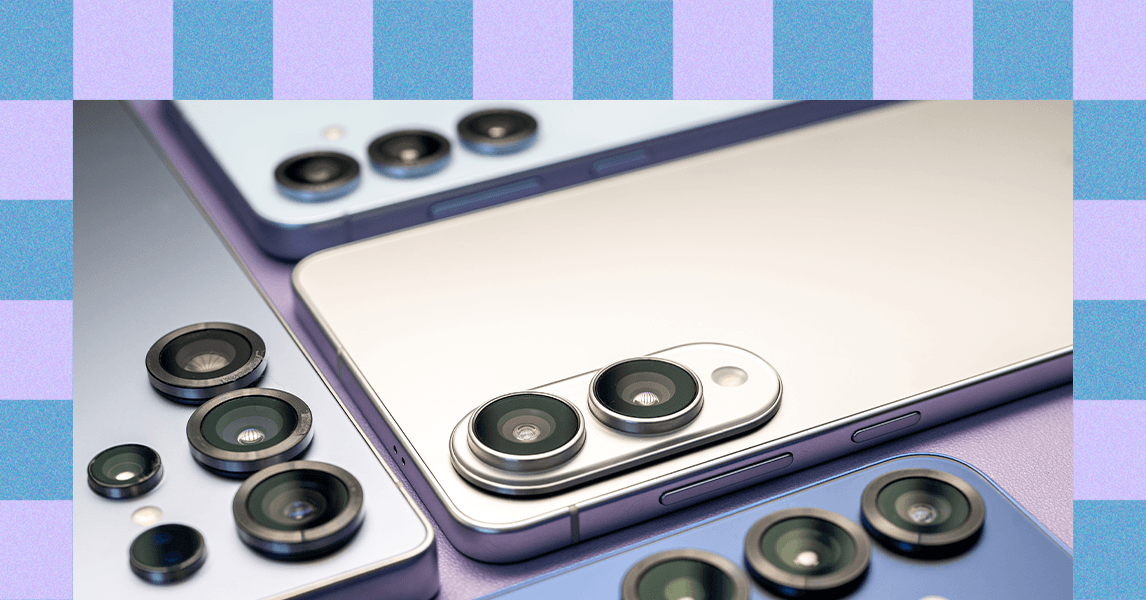Other Samsung Phones to Consider
Photograph: Julian Chokkattu
If you don’t see a Samsung phone mentioned in this guide, that might be because it’s not sold in the US and is a little harder to source for testing. But here are a few other Samsung phones I’ve tried to consider.
Samsung Galaxy A36 5G for $400: The Galaxy A36 (6/10, WIRED Review) doesn’t quite measure up to its peers from Nothing and Motorola. Performance is just too choppy, and that’s not acceptable at this price. It’s manageable—it’s not so slow that it will frustrate—but you can do better. If your needs are very minimal, it’s an OK phone, and the camera system is good, with day-long battery life, a nice AMOLED screen, and 6 years of software updates.
Samsung Galaxy A16 for $200: Samsung’s Galaxy A16 still doesn’t reach the highs of the Galaxy A14, and that’s largely due to sluggish performance. Sure, Samsung is promising six years of software updates, but that remarkable update window doesn’t matter when the phone is frustratingly slow, and you want to throw it out the window. If you barely plan on using this device but want something from a reliable brand that will stay secure, the Galaxy A16 is fine. Its performance just isn’t competitive with other similarly priced phones.
If you’re looking to save some cash, it’s fine to buy Samsung’s Galaxy S23 range or the Galaxy S23 FE from 2023, as long as the prices are a good deal lower than the original MSRP. (They’re hard to find at most major retailers.) These phones will still get support for a while, and they’re pretty great. I don’t think it’s worth buying anything older.
Should You Invest in Samsung’s Ecosystem?
Photograph: Julian Chokkattu
Samsung is one of the few smartphone manufacturers that can match Apple in its hardware ecosystem. Not only does the company make smartphones, but you can also expand your experience by adding on a Galaxy Watch7 smartwatch, Galaxy Buds3 Pro earbuds, Galaxy Ring fitness ring, Galaxy Tab S10+ tablet, and even a Windows-powered Galaxy laptop.
There are certain perks to this, too, like how some features on the Galaxy Ring and Watch7 are only available when paired with a Samsung phone, and its earbuds will automatically switch between Samsung devices based on what you’re using. There’s not much in the way of exclusive features when using a Galaxy phone with a Galaxy laptop, but features like Quick Share let you speedily send photos and documents between your devices.
Again, it’s not necessary, and these other devices might not be the right ones for you within their respective categories, but if you’re chasing hardware parity, you have that option with Samsung.
What Is Galaxy AI?
Photograph: Julian Chokkattu
With the Galaxy S24 series, Samsung launched “Galaxy AI,” a selection of artificial intelligence features, many of which are powered by Google’s Gemini large language models. These enable smart features that may be helpful day to day, like real-time translations during phone calls, real-time transcriptions in Samsung’s Voice Recorder app, the ability to summarize long paragraphs of text in the Samsung Notes app, or change a sentence’s tone with the Samsung Keyboard. In the Galaxy S25 series, Galaxy AI expanded to include Gemini as the default voice assistant and the ability for Gemini to work with multiple apps simultaneously. It also debuted Drawing Assist, which lets you sketch or enter a prompt and get an AI-generated image.
You can find many of these features by heading to Settings > Galaxy AI to toggle them on or off.
What Is Samsung DeX?
Courtesy of David Nield
Samsung’s DeX (short for “desktop experience”) launched in 2017, and it’s a way to plug in your Samsung phone to an external monitor and trigger a desktop version of the Android OS, all completely powered by the phone. You can find a list of compatible Samsung phones here, and you’ll need a monitor, mouse, and keyboard, plus a cable to connect the phone to the monitor. (You can also cast DeX to select screens wirelessly.)
When in DeX mode, you can resize Android apps and have them all open in separate windows. It’s a proper computing platform, though you probably won’t want to use this as a permanent laptop replacement or anything of the sort. It’s great if you’re visiting another office, or working out of a coffee shop or airplane (if you have a portable display). We have a whole guide to setting up and using DeX here.
How I Test Phones
I’ve been reviewing smartphones for a decade, but one of my earliest smart devices was a Samsung Galaxy Captivate, which I got for “free” from my carrier at the time. After working during college, I finally saved enough cash for a Galaxy S3, my first flagship. I’ve spent years using Samsung phones in my personal life and began reviewing them for work not too long after.
With each Samsung smartphone, I always put my personal SIM card inside and spend as long as I can (a few weeks) using the phone as my own. I do camera testing and compare the results with similarly priced devices, I benchmark performance and play graphically demanding games to see how they fare, I try out all the new features, and even take calls to make sure that ol’ function still works fine.
Power up with unlimited access to WIRED. Get best-in-class reporting that’s too important to ignore for just $2.50 $1 per month for 1 year. Includes unlimited digital access and exclusive subscriber-only content. Subscribe Today.
